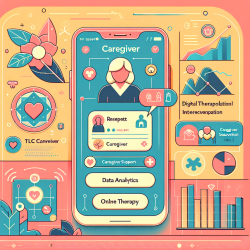Introduction
The demands on caregivers, particularly those caring for individuals with Alzheimer's Disease and Related Dementias (ADRD), are immense. The challenges they face can lead to adverse physical and mental health outcomes. The research article "Maximizing the Benefit of Respite for Dementia Caregivers" introduces a novel intervention, the Time for Living and Caring (TLC) app, which aims to enhance the benefits of respite for caregivers. This blog explores how practitioners can leverage the findings from this study to improve their support for caregivers.
The Importance of Respite
Respite, defined as time away from caregiving duties, is a crucial component of caregiver support. It allows caregivers to attend to their own health, maintain social connections, and pursue personal interests. Despite its importance, many caregivers report dissatisfaction with how they spend their respite time, often engaging in low-priority activities. The TLC intervention seeks to address this by helping caregivers plan and maximize their respite time.
Overview of the TLC Intervention
The TLC app is designed to be a self-administered, technology-facilitated intervention that guides caregivers through a process of assessing their needs, setting goals, and reviewing their respite time use. The app uses an interactive calendar and virtual coaching to help caregivers plan their respite activities. The intervention is based on the theory of "Selective Optimization with Compensation," which helps individuals adapt to changing circumstances by selecting, optimizing, and compensating for their activities.
How Practitioners Can Implement TLC
- Encourage Goal Setting: Encourage caregivers to use the TLC app to set specific, measurable, attainable, relevant, and timely (SMART) goals for their respite time. This process can increase self-awareness and lead to more satisfying and meaningful respite experiences.
- Promote Regular Use: Regular engagement with the app can help caregivers become more self-aware and independent in their respite planning. Practitioners should encourage consistent use to maximize benefits.
- Provide Technical Support: Ensure that caregivers have access to the necessary technology and support to use the app effectively. This may involve providing devices or internet access to those in need.
- Monitor and Review Progress: Use the app's data to monitor caregivers' progress and provide feedback. This can help identify areas for improvement and ensure that the intervention is meeting caregivers' needs.
Encouraging Further Research
While the TLC intervention shows promise, further research is needed to fully understand its impact and potential for scalability. Practitioners can contribute to this research by collecting data on caregiver outcomes and sharing their findings with the broader community. Collaboration with researchers can help refine the intervention and expand its reach.
Conclusion
The TLC intervention represents a significant advancement in caregiver support, offering a data-driven, scalable solution to enhance respite benefits. By implementing the strategies outlined in this blog, practitioners can improve outcomes for caregivers and contribute to the ongoing development of this innovative approach.
To read the original research paper, please follow this link: Maximizing the Benefit of Respite for Dementia Caregivers: A Study Protocol Describing the Development & Evaluation of the Time for Living & Caring (TLC) Intervention.










